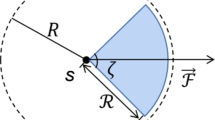Abstract
With the advantages of sensing data’s diversity, camera sensor networks (CSNs) have been applied to objective tracking in both outdoor and indoor environments. In indoor objective tracking, the objectives’ moving mode and sensors’ deployment have limitation and particularity, which bring more challenges on persistent monitoring for CSNs. In this paper, we consider the indoor multi-objective tracking in three-dimensional (3D) CSNs and focus on the 3D camera sensor scheduling for objective tracking to improve the coverage quality of the objective trajectory and minimizing the whole working periods. We firstly introduce the active-period-minimizing scheduling problem in CSNs for indoor objective tracking, with the goal of minimizing the total active periods of sensors. We solve the problem via three algorithms: the first algorithm is designed based on our proposed projection-based algorithm for single-objective case; the second one is proposed with the main idea of path coloring and the third one is a divide-and-conquer strategy with an approximation ratio of \(H(\frac{area(\mathcal {B})}{gside^2})\). To evaluate these algorithms’ performance on the time efficiency, we conduct extensive simulation experiments and analyze their results on the time efficiency advantages and applicable scenarios.








Similar content being viewed by others
References
Bai X, Zhao DN, Bai S, Wang Q, Li WL, Mu DM (2020) Minimum connected dominating sets in heterogeneous 3D wireless ad hoc networks, Ad Hoc Networks 97,102023
Brown T, Wang ZH, Shan T, Wang F, Xue JX (2017) Obstacle-aware wireless video sensor network deployment for 3D indoor monitoring. In: Proceedings of IEEE global communications conference (GLOBECOM), pp 1–6
Cardei M, Du DZ (2005) Improving Wireless Sensor Network Lifetime through Power Aware Organization. Wireless Netw 11(3):333–340
Cardei M, Wu J (2006) Energy-efficient Coverage Problems in Wireless Ad-hoc Sensor Networks. Comput Commun 29(4):413–420
Cardei M, Thai MT, Li YS, Wu J (2005) Energy-efficient Target Coverage in Wireless Sensor Networks, Proc. of IEEE International Conference on Computer Communications (INFOCOM), pp. 1976-1982
Costa DG, Guedes LA (2010) The coverage problem in video-based wireless sensor networks: a survey. Sensors 10:8215–8247
Deif DS, Gadallah Y (2014) Classification of wireless sensor networks deployment techniques. IEEE Commun Surv Tutor 16(2):834–855
Du XF, Wu WL, Kelley DF (1998) Approximations for subset interconnection designs. Theor Comput Sci 207:171–180
Han K, Xiang L, Luo J, Liu Y (2012) Minimum-energy connected coverage in wireless sensor networks with omni-directional and directional features. In: Proceedings of ACM international symposium on Mobile Ad Hoc Networking and Computing. ACM, pp 85–94
Hong Y, Wang YC, Zhu YQ, Li DY, Chang MJ, Chen ZB (2019) Projection-based coverage algorithms in 3D camera sensor networks for indoor objective tracking. In: Proceedings of The 8th international conference on computational data and social networks (CSoNet), pp 309–320
Jia JL, Dong CL, Hong Y, Guo L, Yu Y (2019) Maximizing full-view target coverage in camera sensor networks. Ad Hoc Netw 94:101973
Liu XL, Yang B, Chen GL (2019) Full-view barrier coverage in mobile camera sensor networks. Wireless Netw 25:4773–4784
Shi T, Cheng SY, Li JZ, Gao H, Cai ZP (2019) Dominating sets construction in RF-based batery-free sensor networks with full coverage guarantee. ACM Trans Sensor Netw 15(4): Article 43
Wang Y, Cao GH (2011) On full-view coverage in camera sensor networks. In: Proceedings of IEEE international conference on computer communications (INFOCOM), pp 1781–1789
Wang Y, Song L et al (2016) IntenCT: Efficient Multi-Target Counting and Tracking by Binary Proximity Sensors. Proc. of IEEE International Conference on Sensing, Communication, and Networking (SECON), pp. 1-9
Xu S, Lyu W, Li H (2015) Optimizing coverage of 3d wireless multimedia sensor networks by means of deploying redundant sensors. International Journal of Advanced Studies in Computers, Science and Engineering 4(9):28
Zygowski C, Jaekel A (2020) Optimal path planning strategies for monitoring coverage holes in Wireless Sensor Networks. Ad Hoc Netw 96:101990
Acknowledgements
This research was supported by the Fundamental Research Funds for the Central Universities (No. BLX201921). It was also supported in part by General Project of Science and Technology Plan of Beijing Municipal Education Commission (KM201910017006), Program of Beijing Excellent Talents Training for Young Scholar (2016000020124G056).
Author information
Authors and Affiliations
Corresponding author
Additional information
Publisher's Note
Springer Nature remains neutral with regard to jurisdictional claims in published maps and institutional affiliations.
Rights and permissions
About this article
Cite this article
Hong, Y., Wang, Y., Zhu, Y. et al. 3D camera sensor scheduling algorithms for indoor multi-objective tracking. J Comb Optim 39, 899–914 (2020). https://doi.org/10.1007/s10878-020-00532-0
Published:
Issue Date:
DOI: https://doi.org/10.1007/s10878-020-00532-0




